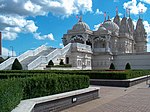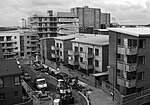St. Raphael's Edible Garden
Botanical gardens in LondonCharities based in BrentCharities based in LondonFood banksGardens in London ... and 2 more
Greenhouses in the United KingdomUse British English from January 2014

St. Raphael's Edible Garden is a community garden located in St. Raphael's, Neasden. The former derelict site was acquired by Sufra in 2016 and was granted permission to build a community garden project by the Brent Council in 2017. The garden is a private space for local residence and visitors as a space to learn and engage in community gardening activities.
Excerpt from the Wikipedia article St. Raphael's Edible Garden (License: CC BY-SA 3.0, Authors, Images).St. Raphael's Edible Garden
Pitfield Way, London Harlesden (London Borough of Brent)
Geographical coordinates (GPS) Address Nearby Places Show on map
Geographical coordinates (GPS)
| Latitude | Longitude |
|---|---|
| N 51.548781 ° | E -0.267024 ° |
Address
St. Raphaels Playground
Pitfield Way
NW10 0PB London, Harlesden (London Borough of Brent, St Raphaels)
England, United Kingdom
Open on Google Maps






